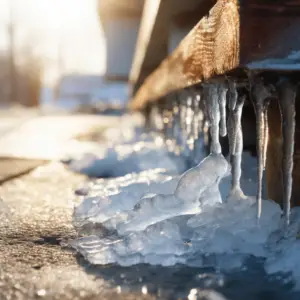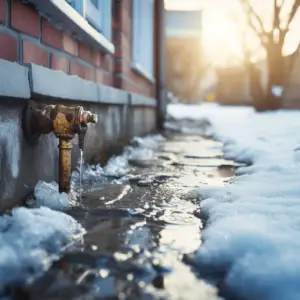Frozen pipes can be a real pain! But, you don’t need to worry. Prevention is easier than you think. Insulate your pipes with foam or heat tape. When it’s cold, leave your faucets dripping a bit. Then, you can avoid the inconvenience and costly damage of frozen pipes.
Opening cabinets under sinks when it’s freezing helps warm air circulate. It’s a small step that makes a big difference! PlumbingSupply.com has an interesting fact: “Pipes in unheated areas like basements, attics, and crawl spaces are vulnerable to freezing.” So, watch out for those areas when taking preventive measures.
Follow these tips and stay alert in cold weather. That way, your pipes won’t freeze and you won’t have to deal with pipe bursts or repairs. Remain prepared and keep your plumbing system running great throughout winter!
Table of Contents
Understanding the Problem

Frozen pipes can be a nightmare! To prevent them, you must first understand how it happens. Cold weather causes water to freeze, and if unprotected, the pipes expand, crack, or burst. Insulating exposed pipes is key. Use materials like foam pipe sleeves or heat tape. Poor insulation in your home can also lead to frozen pipes. Make sure your walls and attic are well insulated. For extra protection, keep cabinet doors open at night to allow warm air circulation. Running a trickle of water from the faucets can prevent quick freezing. Though it increases the water bill, it’s worth it. If leaving for vacation, shut off the main water supply and drain the pipes. Knowing how freezing occurs and taking precautions like these will help protect your pipes from freezing and costly damages.
Reasons Pipes Freeze
To prevent freezing pipes, understanding the reasons behind pipe freezing is crucial. In cold temperatures, insufficient insulation, drafts, and air leaks play a significant role. Each sub-section explores a specific factor that contributes to the freezing of pipes, offering insights and solutions to mitigate the risk.
Cold Temperatures
Cold temps can cause frozen pipes, bringing on major inconvenience and destruction. Here are the main reasons why cold affects your plumbing system:
- 1. When it’s chilly, water in pipes can freeze. This usually happens in pipes that are not insulated or are inadequately insulated.
- 2. Metal pipes contract when temperatures drop and could crack or break. These weak spots can then leak or burst.
- Ice in pipes blocks water flow and can reduce water pressure or totally stop it.
- Cold weather can also affect outdoor plumbing fixtures, like faucets and sprinklers.
- And if a frozen pipe defrosts, flooding could result when the expanding ice causes the pipe to break.
These are the key reasons why cold triggers frozen pipes. Wind chill and prolonged cold further increase the danger.
A study by The National Weather Service found that freezing temperatures caused 2/3 of water pipe failures in colder regions during winter.
Insufficient Insulation
Insufficient insulation is a common cause of frozen pipes. It exposes the pipes to cold temperatures, resulting in water freezing inside. This can happen in both residential and commercial buildings, leading to costly repairs and inconvenience.
During colder months, outside temperatures drop. Without insulation, the pipes are vulnerable to the cold. As water flows through these pipes, it’s susceptible to freezing due to contact with the cold pipe walls. No insulation means no protection. Then, cold air from outside can enter the building, further lowering the temperature – increasing the chance of freezing within the pipes. Result? No running water.
One example of this is Jack. In a small town nestled amidst mountains, winter arrived early. Jack felt an unsettling chill in his home – his pipes were frozen due to insufficient insulation. The next morning, no water flowed. Until swift action was taken, water damage was imminent.
A local plumber found Jack’s lack of insulation had allowed winter conditions to damage his plumbing system. Jack learned the importance of proper insulation for preventing frozen pipes – the hard way.
Drafts and Air Leaks
Drafts and air leaks can cause frozen pipes. Cold air can enter through cracks or gaps in walls, windows, and doors. So, it’s important to address these issues. Here are the factors related to drafts and air leaks that can cause frozen pipes:
- Insufficient insulation: Cold air can penetrate and cause the pipes to freeze in areas with inadequate insulation like basements, attics, or crawl spaces.
- Gaps around pipes: Cold air can seep in from any gaps or openings around the pipes.
- Cracks in walls: Exterior wall cracks provide a path for cold air to reach the pipes. This is common in older homes.
- Damaged weatherstripping: Weatherstripping around doors and windows creates a seal. If it’s damaged or worn out, it can lead to drafts and frozen pipes.
- Poorly sealed vents: Vents need proper sealing to prevent cold air infiltration.
- Pipe placement: Pipes near exterior walls or unheated areas are more likely to freeze due to drafts and air leaks.
To minimize the risk of frozen pipes, make sure there’s sufficient insulation, seal gaps or openings, repair cracks, replace weatherstripping, properly seal vents, and consider relocating exposed pipes.
Pro Tip: Let faucets drip slowly in extremely cold weather to prevent pipe freezing.
The Importance of Preventing Freezing Pipes
It’s critical to safeguard your plumbing system from freezing pipes. This neglect can lead to costly repairs and trouble. Here’s why it is so important:
- Stop Burst Pipes: Freezing water causes immense pressure on pipes, which can lead to them breaking. This can cause major damage to your property.
- Prevent Water Damage: Broken pipes can cause water damage, resulting in mould growth, structure problems, and expensive repairs.
- Protect Items: Frozen pipes can affect not just your plumbing but also valuable possessions near the affected spot, like furniture, electronics, and emotional items.
- Maintain Water Supply: If your pipes freeze, you won’t have access to clean water for drinking, cooking, cleaning, or other necessary activities.
- Energy Efficiency: When pipes freeze, your heating system has to work more to give hot water around your home, making bills higher.
In addition to these points, it’s essential to make sure that all exposed pipes are cushioned with items like foam pipe sleeves or heat tapes. Taking these steps will reduce the chance of frozen pipes.
To stop any further worries from potential pipe issues during cold temperatures, take the necessary precautions now. The right insulation and regular monitoring will guarantee a relaxed winter and protect your home from unexpected costs and hassles!
Tips for Preventing Pipes from Freezing
To prevent your pipes from freezing, use these effective tips. Keep the heat on, insulate exposed pipes, seal drafts and air leaks, let faucets drip, and open cabinet doors. These simple solutions will help safeguard your pipes and prevent costly damages.
Keep the Heat On
Keeping the heat on is essential to prevent pipes from freezing. Having a consistent temperature in the house can help avoid damage and costly repairs. Here are some tips to keep the heat going:
- Insulate pipes. Use foam insulation sleeves or heat tape for an extra layer of protection. Insulation helps keep pipes warm.
- Seal any air leaks. Check walls, windows, and doors near pipes. Cold air can cause a drop in temperature, increasing the risk of freezing. Use caulk or weatherstripping to block the cold air.
- Let faucets drip. This relieves pressure and prevents freezing. Even a little trickle of water helps.
- Keep interior doors open. This allows warm air to circulate and prevents cold spots around pipes.
- Set thermostat correctly. Keep the thermostat at a consistent temperature, no lower than 55°F (13°C).
These steps can help protect pipes from freezing. Prevention is key to avoid costly repairs and inconvenience. Take action before winter to make sure your plumbing system stays warm and worry-free.
Insulate Exposed Pipes
Protect your pipes from freezing temps and costly repairs! Insulating exposed pipes is essential. Here are three steps for how to do it right:
- Figure out where all the exposed pipes are in your home – attics, crawl spaces, and exterior walls.
- Measure the length and diameter of each pipe. Get insulating material that fits snugly around them.
- Slide the insulation over the pipe and make sure it covers from end-to-end. Secure with zip ties or tape.
Also, don’t forget to cover outside faucets with faucet covers or foam insulation. My neighbor didn’t take these precautions and her pipes froze. She ended up with a burst pipe and major water damage in her basement. Don’t let this happen to you – insulate your pipes now!
Seal Drafts and Air Leaks
Caroline had a horror story. She moved into an old house in winter and her pipes froze. She learnt that even little drafts can cause major issues. To never face this again, she took action. She used weatherstripping and caulk to seal all possible leaks. Her hard work paid off – she never experienced a frozen pipe issue again!
To remember Caroline’s story, here are 6 steps to seal drafts and air leaks:
- Identify the leaks, look for cracks or gaps.
- Use weatherstripping around doors and windows.
- Seal any visible cracks with caulk.
- Wrap insulation sleeves around exposed pipes.
- Seal attic hatches with weatherstripping or foam tape.
- If unsure, consult a professional.
Plus, make sure to monitor your heating regularly and maintain the right temperature. Prevention is always better than dealing with frozen pipes!
Let Faucets Drip
Drip faucets can help keep pipes from freezing. Here are some tips to do it:
- Tip 1: Keep a faucet dripping during cold weather. This helps reduce pressure in pipes and stops them from freezing and bursting.
- Tip 2: Choose a faucet on an outer wall or near the main water line. These areas are more likely to freeze, so keeping water flowing helps prevent blockages.
- Tip 3: Set the dripping faucet to a slow, steady flow. This keeps water moving and ice from forming.
- Tip 4: Open cabinet doors under sinks when it’s very cold. This lets warm air from home heating circulate around pipes, giving extra insulation and stopping freezing.
Also, be careful when leaving faucets dripping if you have a private well or septic system. Too much water can strain these systems. If you notice any leaks or drips, fix them quickly. Even small leaks can lead to frozen pipes if not taken care of.
To sum up, dripping faucets can stop pipes from freezing by relieving pressure, keeping water flowing, and providing extra insulation. By following these steps and fixing any leaks, you can help protect plumbing in cold weather.
Open Cabinet Doors
Opening cabinet doors is a great way to avoid pipes freezing! Here are five key points to keep in mind:
- Warm air can flow around the pipes, stopping them from freezing if you open the cabinet doors.
- Heat is easily able to reach pipes running through cabinets, especially those against exterior walls if the doors are open.
- Keep doors open constantly during cold weather, as closed doors act as a barrier limiting heat flow and resulting in pipe freeze-ups.
- If you don’t want to leave the doors open all the time, use curtains or slatted doors to make it look nicer.
- Don’t forget to clear any items that might block the warmth from reaching the pipes when you open the cabinet doors.
Plus, if your kitchen sink is against an exterior wall, open both upper and lower cabinets for optimal airflow.
Pro Tip: To further prevent freezing, let the faucets drip slightly to keep water flowing in the pipes.
What to Do If Pipes Still Freeze
To tackle the issue of frozen pipes, equip yourself with the knowledge of what to do if the pipes still freeze. Discover effective solutions within the sub-sections: Shut Off Water Supply and Thawing Frozen Pipes.
Shut Off Water Supply
Pipes often freeze in winter, resulting in costly repairs for homes. Here’s a guide for how to shut off the water supply in those situations:
- Find the main water valve. It’s usually close to the water meter or where the main pipe enters your home. It could be in a crawl space, basement, utility room, or near an exterior wall.
- Use a wrench or pliers to turn the valve clockwise until it stops. This shuts off the water supply to your whole house.
- Open all faucets (hot and cold) in the house. Then, drain any remaining water from the pipes.
- Insulate exposed pipes against freezing. Use insulation sleeves or wraps designed for this purpose.
- If you’re not sure about handling frozen pipes, call a licensed plumber.
Prevention is key. Keep interior temperatures consistent. Allow faucets to drip during cold weather. This helps stop pipes from freezing.
Failing to shut off the water supply when it’s cold can cause burst pipes and extensive damage. Don’t let it happen. Make sure you know how to turn off the water supply if your pipes freeze.
Thawing Frozen Pipes

If your pipes are frozen, it’s important to act quickly to prevent further damage. Follow these steps to thaw your pipes safely and effectively:
- Open all faucets connected to the frozen pipes. This will release any pressure build-up.
- Use a hairdryer or heat lamp to warm the pipe closest to the faucet.
- Don’t use an open flame or direct heat source as this could cause harm or start a fire.
- If the frozen section is not accessible, use hot towels soaked in hot water or an electric heating pad to provide indirect heat.
- After the water starts flowing again, keep the affected faucets open to melt any remaining ice.
- Check for leaks and inspect the pipes for signs of damage.
Be aware that not all pipes can be thawed using these methods. Certain types of plastic or PVC pipes may require professional help due to their sensitivity to heat.
Act fast when dealing with frozen pipes. The longer you wait, the more likely you are to have burst pipes and extensive water damage. Don’t let potential disasters happen – thaw your frozen pipes now!
Conclusion
To shield pipes from freezing, there are some steps to take. First off, put foam pipe insulation on exposed pipes in the home. It will keep the pipes warm and stop them from freezing. Plus, install heat tape on the pipes for an extra layer of defense against cold temperatures.
Also, properly drain and detach outdoor hoses or sprinkler systems before winter. Water left inside can freeze and damage the equipment and pipes. Plus, keep the home at a consistent temperature even if away on vacation. This will help ensure pipes stay warm and don’t freeze.
Be aware of signs your pipes may be freezing. Low water flow or no water out of a faucet may mean a frozen pipe. Taking fast action is essential to prevent more damage. Know where the main shut-off valve is and how to use it.
By following these steps, the risk of frozen pipes can be reduced and avoid costly repairs. Taking proactive moves now saves time, money, and stress later.
A family’s true story serves as a reminder: take preventive measures to safeguard pipes in cold weather. They left their vacation home for months without winterizing the plumbing system. When they came back, they saw multiple pipes had frozen and burst. The water damage was extensive and needed costly repairs.
Frequently Asked Questions
Q: Why is it important to prevent pipes from freezing?
A: Freezing pipes can cause them to burst, leading to costly water damage and repairs. Preventing freezing can save you from such troubles.
Q: How can I keep my pipes from freezing in cold weather?
A: Here are some tips to prevent freezing pipes:
- Insulate pipes located in unheated areas of your home, such as the attic, basement, or crawl spaces.
- Seal any gaps or cracks in the walls near pipes to prevent cold air from reaching them.
- Keep cabinet doors open to allow warm air to circulate around pipes under sinks.
- Let cold water drip from faucets connected to exposed pipes to keep water flowing.
- Keep your thermostat at a consistent temperature day and night, even when you’re away.
- If you’re going on vacation during cold weather, leave the heat on in your home or set it to a minimum of 55°F (12°C).
Q: Are there any specific products I can use to prevent freezing?
A: Yes, you can consider using pipe insulation sleeves or heat tape to add an extra layer of protection to vulnerable pipes. These products are widely available in hardware stores.
Q: How can I thaw frozen pipes?
A: If your pipes are already frozen, you can try using a hairdryer or heating pad to gently thaw the area. Be sure to start from the faucet end and work your way toward the frozen section. Never use an open flame or high heat source.
Q: What should I do if my pipes have burst?
A: If a pipe bursts, immediately shut off the main water supply and contact a plumber for emergency repairs. Remove any water-damaged items to prevent mold and ensure proper cleanup.
